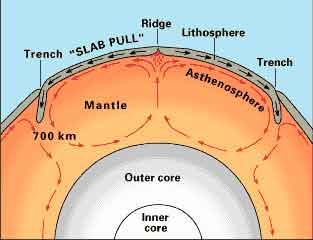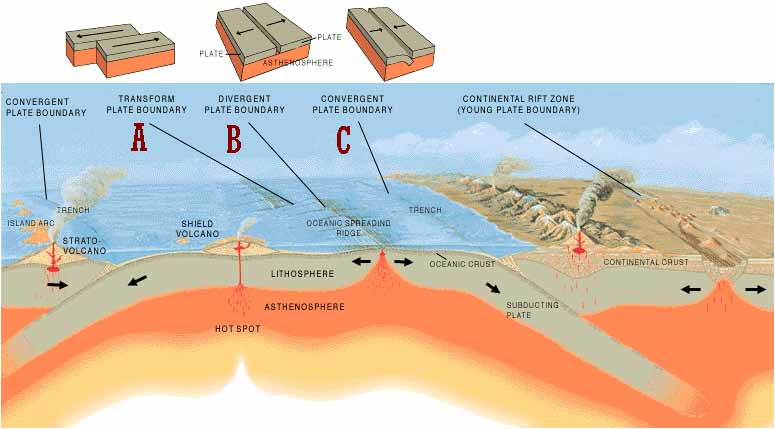|
The earth's crust is made up of many different sections, known
as plates. Deep under these plates is the mantle, which is always
in motion (see diagram below). As the mantle circulates,
pressure builds on the plates. In order to release the pressure,
the plates need to move. Sometimes the movement is very slow,
constantly releasing pressure, and sometimes the movement is very
quick and violent from pressure build-up (an earthquake).
 |
Left: Interior of earth showing the cycling
of the mantle. Notice the areas where plates are spreading,
the mantle is pushing upward to form a ridge.
Right: This is a map that identifies the
major plates of the world by the different colors. Notice
that where the Pacific Plate and the North American Plate
meet in California is the San Andreas Fault line.
|
 |
There are four main types of plate boundaries
(the area where two plates meet). They include:
- Transform boundaries: plates slide horizontally past
each other, no crust is made or lost. (A)
- Divergent boundaries: two plates pull apart as new
crust is made. (B)
- Convergent boundaries: two plates come together, with
one plate diving under the other, destroying crust. (C)
- Plate boundary zones: broad areas in which boundaries
are not well defined.

This picture illustrates transform, divergent, and convergent
boundaries. Notice the illustrations above the
diagram representing the direction in which the plates are moving.
(Cross section by José
F. Vigil.)
|
|
Since there are three main
types of plate boundaries, transform (sliding), divergent (extending),
and convergent (compressing), there are three main types of
earthquakes.
Characteristics of Earthquakes
| |
Transform
Plate
Boundary |
Divergent
Plate
Boundary |
Convergent
Plate Boundary |
| Location |
Close to surface |
Close to surface |
Any depth |
| Intensity |
Ranging, usually
less than 8.5 |
Usually not severe,
less than 8.0 |
Can be very strong,
some greater than 9.0 |
Learn more about the
San Andreas fault in California!
|
